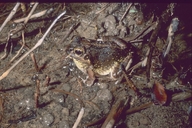|
Description
M 42-48 mm, F 64 mm, specimens of up to 80 mm known. Tibiotarsal articulation reaches the eye. Hands without webbing, foot webbing 1(0-0.5), 2i(1), 2e(0.5), 3i(1.5), 3e(1), 4i/e(2-2.5), 5(1). Fingers and toes without terminal discs. Skin granular with two longitudinal dorsal folds. Males with a black nuptial pad on the first finger, and a slightly bilobate subgular vocal sac. Colouration variable, usually greyish brown with lighter and darker markings. Ventrally white, with dark pigment on the throat.
This is the only representative of the Mantellidae without intercalary elements between the terminal and subterminal phalanges of fingers and toes. Distribution and Habitat
Country distribution from AmphibiaWeb's database: Madagascar
Endemic to Madagascar. Distributed over most of western Madagascar and reaching into some parts of the north and the southern-central highlands where dry conditions prevail. Occurs below 800m asl (IUCN 2008). Found in Ambalavao, Andafiabe, Andavaka, Andohahela, Andranohinaly, Ankarafantsika (Ampijoroa, Ankarokaroka, Antsiloky, Lac Tsimaloto), Ankarana, Antranopasasy, Antsirasira, Baly, Benavony, Bendrao Forest, Berenty, between Ejeda - Ampanihy, Cap Sada, Ifaty, Ilovo, Isalo, Itremo, Kirindy, Mahajanga, Marofandilia, Montagne des Français, Pic St. Louis, Port Bergé Vaovao, Ranohira, Soalala, Toliara, Vohibasia forest, West of Ihosy, Zombitse. Mostly occurs in open areas.Life History, Abundance, Activity, and Special Behaviors
Hidden in the ground during the dry season. Explosive breeder after the first heavy rains. Males call at night from positions on the ground next to the edge of lentic water bodies.
Calls: A fast series of 25-35 unharmonious notes, with a repetition rate of 16-18 notes per second. Comments
Taken with permission from Glaw and Vences (2007).
References
Datong, Y., and Shunqing, L. (2004). Cynops cyanurus. In: IUCN 2008. 2008 IUCN Red List of Threatened Species. www.iucnredlist.org. Downloaded on 11 March 2009.
Glaw, F., and Vences, M. (2007). Field Guide to the Amphibians and Reptiles of Madagascar. Third Edition. Vences and Glaw Verlag, Köln.
Originally submitted by: Frank Glaw and Miguel Vences (first posted 2000-11-30)
Edited by: Kellie Whittaker (2009-01-30)Species Account Citation: AmphibiaWeb 2009 Laliostoma labrosum <https://amphibiaweb.org/species/5202> University of California, Berkeley, CA, USA. Accessed Jun 10, 2025.
Feedback or comments about this page.
Citation: AmphibiaWeb. 2025. <https://amphibiaweb.org> University of California, Berkeley, CA, USA. Accessed 10 Jun 2025.
AmphibiaWeb's policy on data use.
|
